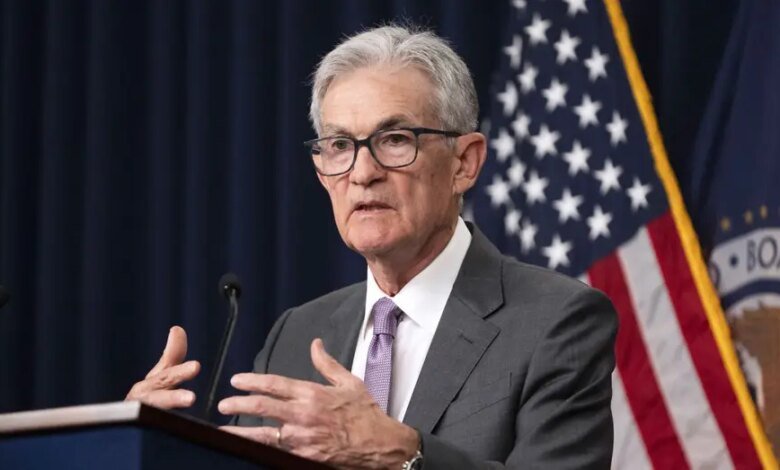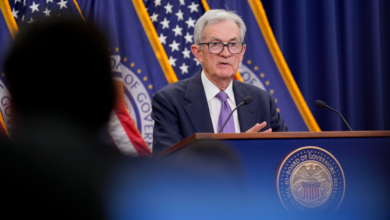Fed cuts interest rates for second time amid signs of labor market weakness

Jerome Powell delivers his remarks after announcing the Federal Reserve’s interest rate decision.
the Federal Reserve The Federal Reserve on Wednesday announced an interest rate cut for the second time this year as policymakers moved to support the labor market despite inflation remaining above the central bank’s target.
Fed policymakers voted to cut the federal funds rate by 25 basis points to a new range of 3.75% to 4%. The move follows a rate cut of this size in September, which was the first cut of the year.
Policymakers have been watching economic data, Which showed a slowdown in the labor market in recent months as companies struggle with changes in trade and immigration. At the same time, inflation trended higher as tariff-related price increases seeped into government data.
These trends have put the Fed in a bind as it looks to achieve its dual goals of price stability in line with its 2% long-term inflation target as well as promoting maximum employment.
Powell points to continued weakness in the labor market as the government shutdown delays official reports
Federal Reserve Chairman Jerome Powell said the central bank remains alert to risks related to employment and inflation. (Roberto Schmidt/AFP via Getty Images/Getty Images)
The Federal Open Market Committee (FOMC), which guides the central bank’s monetary policy moves, noted in its announcement that there are risks on both sides of its dual mandate as job gains have slowed this year, with the unemployment rate rising but remaining relatively low, while inflation has increased and remains high.
The Federal Open Market Committee’s vote in favor of an interest rate cut was 10-2. Fed Governor Steven Meiran dissented in favor of a larger cut of 50 basis points, while Kansas City Fed President Jeffrey Schmid opposed a rate cut at this meeting.
Fed Chair Jerome Powell said in the press conference following the announcement that policymakers remain focused on the dual mandate and noted that while the government shutdown has delayed some important economic data from federal agencies, available public and private data “suggest that employment and inflation expectations have not changed much since our meeting in September.”
Fed 5: Besant’s shortlist for Powell’s job
“Despite the delay in official September employment data, available evidence suggests that layoffs and hiring remain low, and that households’ perceptions of job availability and businesses’ perceptions of hiring difficulty continue to decline,” Powell said.
“Inflation has risen in goods. In contrast, lower inflation appears to be continuing in services. Measures of near-term inflation expectations have generally risen over the course of this year on news of tariffs, as reflected in both market and survey-based measures,” Powell said, noting that longer-term expectations remain consistent with the 2% inflation target.
“We remain committed to supporting maximum employment, sustainably bringing our inflation to our 2% target and maintaining the long-term outlook well,” Powell explained. “Our success in achieving these goals matters to all Americans. We recognize that our actions impact communities, families and businesses across the country. Everything we do is in service of our public mission.”
Powell said the Fed viewed interest rate cuts in September and October as insurance, moving monetary policy closer to a neutral level in light of its dual mandate goals that conflict with the risk of higher inflation and a weak labor market.
The Chairman said the September CPI showed that the rise in goods inflation was due to higher tariff-linked prices, while housing services inflation was trending downward and non-residential services had moved sideways in recent months.
“If you add all that up, inflation apart from the tariffs is actually not that far from our target of 2%. We estimate – and people have different estimates of what it is – but it might be 5 or 6 tenths, so if it’s 2.8%, the core personal consumption expenditures that don’t include the tariffs might be 2.3% or 2.4%,” he explained.
While non-tariff inflation is relatively close to target, Powell said that “consumers are not interested in this story, their prices are higher.”
“More than that, the reason they’re unhappy with inflation is the inflation that we’ve had in 2021, 2022, 2023, because you can say prices won’t go up as much, but that doesn’t mean people don’t feel those higher prices because of the inflation that we had two or three years ago. They do feel that, and I think that’s a big part of the reason why the public, if you take a sample of people, inflation is still making people quite unhappy.” He explained.
Powell was asked whether the Fed was concerned that a prolonged government shutdown might leave it relying more anecdotal data in interest rate cutting decisions due to a lack of government data.
“This is a temporary situation,” Powell said. “We will collect every piece of data we can find, evaluate it and think about it carefully.”
When asked if that might impact the Fed’s December meeting, Powell said that although he wasn’t saying so, he explained: “What do you do if you’re driving in fog? You slow down. So that may or may not be possible. I don’t know how that will affect things.”
The chairman explained: “The data may come back, but there is a possibility that it would make sense to be more cautious about moving. Again, I’m not committed to that. I’m just saying that it’s certainly a possibility that you might say, we can’t really see, so let’s slow down.”
This is a developing story. Please check back for updates.
Don’t miss more hot News like this! Click here to discover the latest in Business news!
2025-10-29 18:00:00




